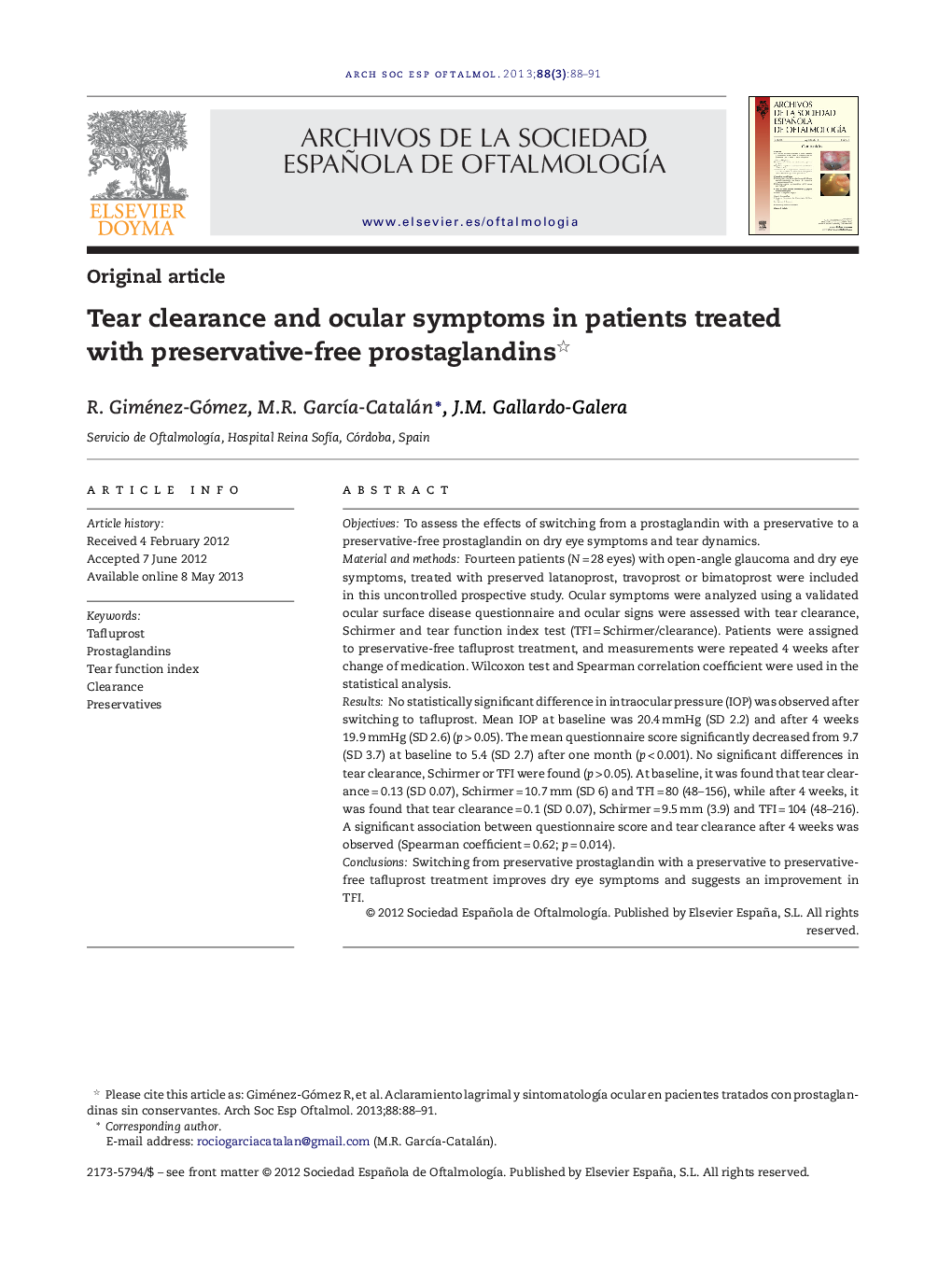| Article ID | Journal | Published Year | Pages | File Type |
|---|---|---|---|---|
| 4008466 | Archivos de la Sociedad Española de Oftalmología (English Edition) | 2013 | 4 Pages |
ObjectivesTo assess the effects of switching from a prostaglandin with a preservative to a preservative-free prostaglandin on dry eye symptoms and tear dynamics.Material and methodsFourteen patients (N = 28 eyes) with open-angle glaucoma and dry eye symptoms, treated with preserved latanoprost, travoprost or bimatoprost were included in this uncontrolled prospective study. Ocular symptoms were analyzed using a validated ocular surface disease questionnaire and ocular signs were assessed with tear clearance, Schirmer and tear function index test (TFI = Schirmer/clearance). Patients were assigned to preservative-free tafluprost treatment, and measurements were repeated 4 weeks after change of medication. Wilcoxon test and Spearman correlation coefficient were used in the statistical analysis.ResultsNo statistically significant difference in intraocular pressure (IOP) was observed after switching to tafluprost. Mean IOP at baseline was 20.4 mmHg (SD 2.2) and after 4 weeks 19.9 mmHg (SD 2.6) (p > 0.05). The mean questionnaire score significantly decreased from 9.7 (SD 3.7) at baseline to 5.4 (SD 2.7) after one month (p < 0.001). No significant differences in tear clearance, Schirmer or TFI were found (p > 0.05). At baseline, it was found that tear clearance = 0.13 (SD 0.07), Schirmer = 10.7 mm (SD 6) and TFI = 80 (48–156), while after 4 weeks, it was found that tear clearance = 0.1 (SD 0.07), Schirmer = 9.5 mm (3.9) and TFI = 104 (48–216). A significant association between questionnaire score and tear clearance after 4 weeks was observed (Spearman coefficient = 0.62; p = 0.014).ConclusionsSwitching from preservative prostaglandin with a preservative to preservative-free tafluprost treatment improves dry eye symptoms and suggests an improvement in TFI.
ResumenObjetivosEvaluar el efecto en los síntomas de sequedad ocular y en la dinámica lagrimal que se produce al sustituir una prostaglandina con conservante por una prostaglandina sin conservante.Material y métodosEstudio prospectivo no controlado en el que se seleccionaron 28 ojos de 14 pacientes con síntomas de ojo seco en tratamiento con latanoprost, travoprost o bimatoprost con conservante. Se evaluaron los síntomas oculares con un cuestionario validado de enfermedad de la superficie ocular y los signos mediante el test de aclaramiento lagrimal, el Schirmer y el índice de función lagrimal (TFI, TFI = Schirmer/Aclaramiento). En todos los pacientes se cambió el tratamiento hipotensor a tafluprost sin conservante. Al mes, se repitieron los tests. En el análisis estadístico se utilizó el test de Wilcoxon y el coeficiente de correlación de Spearman.ResultadosNo encontramos diferencias en la presión intraocular (PIO) al cambiar a tafluprost. La PIO inicial era 20,4 mmHg (DE 2,2) y la PIO al mes era 19,96 mmHg (DE 2,6) (p > 0,05). La puntuación del cuestionario disminuyó de forma significativa desde 9,7 (DE 3,7) a 5,4 (DE 2,7) al mes del tratamiento (p < 0,001). No encontramos diferencias significativas en el aclaramiento, en el Schirmer, ni en el TFI (p > 0,05). Inicialmente, Aclaramiento = 0,13 (DE 0,07), Schirmer = 10,7 mm (DE 6) y TFI = 80 (48-156). Al mes, Aclaramiento = 0,1 (DE 0,07), Schirmer = 9,5 mm (DE 3,9) y TFI = 104 (48-216). Hemos encontrado una asociación significativa entre la puntuación del cuestionario y el aclaramiento al mes (coeficiente de correlación = 0,62; p = 0,014).ConclusionesLa sustitución de una prostaglandina con conservante a tafluprost sin conservante mejora los síntomas de sequedad ocular y sugiere una mejoría en el test de función lagrimal.
